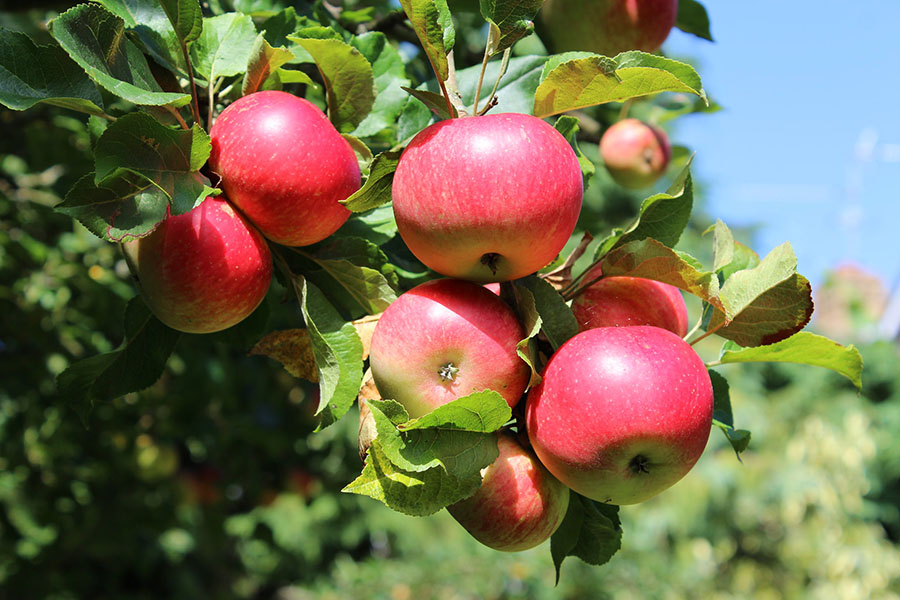Six Fruit Trees and Plants That Will Thrive in Your Philly Rowhouse Garden
Think your postage-stamp yard’s too petite for an orchard? Not with these easygoing plants.

Photo by DataHamster via Flickr Creative Commons
One of the first things my daughter and her husband did when they bought a house in 2016 was plant an apple tree. It was an impulse buy, at Home Depot. I, a gardener for more than four decades, winner of gardening awards and writer on the subject for various publications, smiled encouragingly but secretly sniffed. My kid can’t keep a cactus alive, much less a fruit tree. What about pruning? Fertilizing? Pollination? Who puts an apple tree in a yard the size of a batting box?
To my utter shock, the damn thing bloomed come springtime. Then it set fruit — half a dozen little green apples that slowly, slowly ripened. Granted, they then fell off. We ate them off the ground. They were …. pretty sour. But I have to say, looking out their window and seeing apples on that tree was pretty amazing. So if you think you, too, might enjoy becoming a fruit farmer, here are some nearly goof-proof ways to, um, branch out.
Note: If you’re uncertain about the quality of your soil — and if you live in the city, you have cause to be — you can send a sample away for testing. Penn State offers a soil-testing program, as do many local garden centers. And whether you have your soil tested or not, mix in some organic matter — compost is great — when you plant. (Philly residents can get up to 30 gallons free from the Fairmount Park Organic Recycling Center.) Just remember the cardinal rule of gardening: Dig your hole twice as deep and twice as wide as you think you should.
Figs
This may seem like kind of an esoteric place to start. Figs are fancy, right? They’re also pretty easy to grow in our local hardiness zone, which is 7. Got a ficus tree in your living room? That’s a fig tree — just one that hardly ever sets fruit indoors. For sweet, jammy figs right in your own yard, Ficus carica ‘Brown Turkey’ is a tried-and-true self-pollinating cultivar with simple needs. It tops out at about 20 feet but can be pruned smaller, to keep size within bounds. It likes a spot with some shelter but full sun. You’ll want to top-dress with more compost annually, and water if the weather’s been dry. Eat your figgies fresh or dried and impress your friends!
Limes
And not just limes — also Meyer lemons, and the tart little oranges known as calamondins. When citrus trees blossom, the smell is absolutely heavenly. They also self-pollinate, so you only need one, which is a good thing, since in these parts, they’re not reliably winter-hardy. You’ll do best growing them in pots, keeping them outside in summer on a porch, patio or deck and finding a bright spot for them indoors in winter. But that’s when they flower and fruit, so you won’t mind. Be careful not to over-water, which causes leaves to yellow and drop. Feed with a citrus fertilizer monthly, and keep an eye out for spider mites and scale insects, which leave a residue called “honeydew” that makes leaves shiny and sticky. Bright sun, please, both indoors and out. With a bit of effort, you’ll be serving homegrown lime gin rickeys all around! For a fun home project with kids, try growing your own citrus trees from seeds.
Blueberries
What could be better than picking blueberries in your own backyard? The little bushes are fairly carefree; a raised bed is a good idea, and you’ll get a better crop if you bunch them together rather than spread them out. You’ll also get more fruit if you plant more than one variety, for cross-pollination. (Make sure they flower at the same time of year.) Blueberries like acidic soil, which is why they’re so happy in Jersey; you can acid yours up by working pine bark or pine needles into the soil. (There are varieties particularly suited to growing in containers, which lets you tailor-adjust your growing medium.) The first year you plant, pinch off flowers and/or fruit to encourage root growth. After that, you may want to put netting over your ripening crop to discourage hungry birds.
Strawberries
Nah, they don’t grow on trees or bushes. But they’re supremely easy and rewarding. Every spring, local gardening goliath Burpee offers dozens of varieties, from tiny alpines to heirlooms to modern monsters. You can put them in strawberry pots (very ornamental) or in a bed; read up a little on how they self-propagate. (It has to do with mothers and daughters — Mother’s Day gift alert!) You can even grow them as a ground cover or in hanging baskets. But they’re shallow-rooted plants (don’t set them too deep!), so frequent watering is important, especially in the run-up to when they fruit, which is in early summer for the most productive varieties, known as “June-bearers.” “Everlasting” and “day neutral” varieties produce over a longer season, but less prolifically. Again, watch for birds.
Grapes
Yes, grapes. A guy I know has a grape-stomping party every year for the crop he grows in his backyard and uses to make wine. Good old Concord grapes, descended from the native plants the Vikings found here, are reliable and self-pollinating — and they smell incredible when they ripen — but there are lots of newer cultivars to choose from. Decide what you want your grapes for: Do you plan to eat the fruit fresh, make jam or jelly, or try your hand at vintner-ing? Whatever the variety, they need full sun and balanced soil, and good air circulation is a must. There will be some trellising and pruning involved, but that’s when you get to pretend you’re in Tuscany.
Apples
Okay, okay—nothing but a real tree will do! Did you know fruit trees come in three sizes? For a city backyard, stick to dwarf (or if you have more room, semi-dwarf). Again, you’ll have to consider pollination, and plant two varieties that bloom at the same time — or look for trees with more than one type grafted onto the trunk. Like all these kinds of fruit, they do best in full sunlight. There’s some pruning and fertilizing in your future if you go this route — but also, apple blossoms! If you want to get really fancy (or you’re working with a long and narrow backyard), you can espalier your apple tree (or pear, or peach) against a fence or wall.


